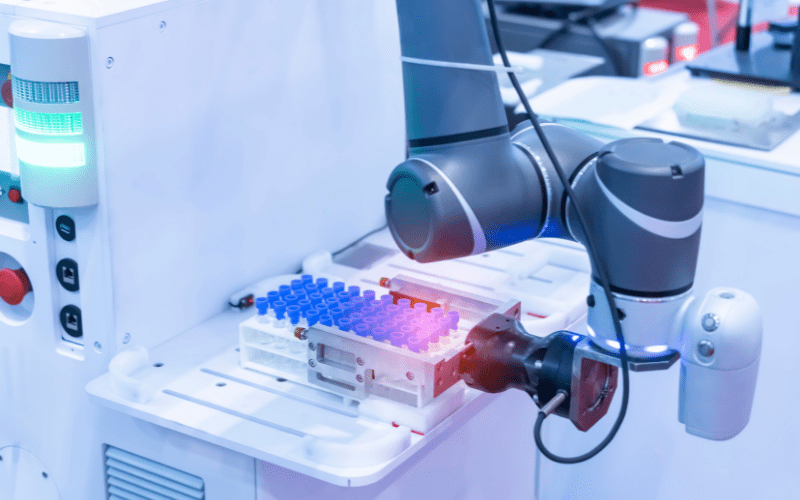
The clinical lab automation market is witnessing a significant transformation as healthcare facilities increasingly adopt automated solutions to enhance testing precision and speed. According to the latest report from Meticulous Research®, the global clinical lab automation market is projected to reach $4.01 billion by 2031, growing at a CAGR of 7.8%. This growth is primarily driven by the rising geriatric population, an increase in infectious disease prevalence, and continuous advancements in laboratory technologies. However, high equipment costs and limited funding in some regions pose challenges to widespread adoption.
Download Sample Copy: https://www.meticulousresearch.com/download-sample-report/cp_id=5762
Key Market Drivers and Restraints
- Growing Geriatric Population
As populations age worldwide, the demand for diagnostic services rises, pushing healthcare facilities to adopt efficient solutions to manage higher sample volumes. Automation in clinical labs helps streamline workflows, making it a critical tool for handling the increased demand. - Prevalence of Infectious Diseases
Infectious diseases continue to be a major public health concern globally. Automated lab solutions enable quicker and more accurate testing, allowing healthcare providers to diagnose and treat infectious diseases faster. - Technological Advancements in Clinical Lab Instruments
Advances in molecular diagnostics, artificial intelligence, and robotics are transforming the clinical lab landscape, making it more efficient. Automated instruments can manage complex tasks like sample preparation, testing, and analysis with minimal human intervention, reducing human error and improving accuracy. - Challenges: High Costs and Infrastructure Limitations
Although automation offers substantial benefits, the initial setup costs can be prohibitive. Additionally, developing countries often lack the infrastructure and funding needed to support high-end automation systems. Maintenance and repair costs for advanced equipment can further strain limited budgets in these regions. - Privacy and Security Concerns
As clinical lab automation involves the handling of sensitive patient data, concerns around data security and patient privacy remain a critical issue. With an increase in cyber threats, the implementation of secure and compliant systems is essential to safeguard patient information.
Market Segmentation and Product Insights
The clinical lab automation market is segmented by product, end user, and geography, each category highlighting unique aspects of the industry.
1. Product Insights: Systems Leading the Market
- Automated Systems: Automated systems—including liquid handling, ELISA, nucleic acid purification, and microplate readers—are expected to hold the largest market share by 2024. These systems reduce manual labor, limit human error, and boost throughput, making them highly efficient for laboratory operations. With growing demand, these systems are proving indispensable for labs striving to manage high sample volumes efficiently.
- Clinical Lab Automation Software: This software enhances data integration and management, supporting lab operations by streamlining information flow and enabling quick access to test results. This trend aligns with the shift toward digitalized healthcare solutions, facilitating data sharing and analysis across facilities.
2. End User Insights: Hospital Laboratories Dominate
- Hospital Laboratories: Hospital laboratories are anticipated to hold the largest market share by 2024. This dominance is attributed to several factors, including rising healthcare expenditures, an increasing prevalence of chronic diseases, and growing sample loads in hospitals. Improved healthcare infrastructure in developing countries also boosts this segment, as hospitals worldwide look to automation to keep pace with high diagnostic demands.
- Diagnostic Laboratories: Diagnostic laboratories are also essential end users in this market, leveraging automation to improve testing capacity and efficiency. With a heightened focus on early disease detection and personalized medicine, diagnostic labs are investing in advanced automation technologies to enhance patient outcomes.
Get Customized Report: https://www.meticulousresearch.com/request-customization/cp_id=5762
Geographic Insights: Regional Analysis of the Clinical Lab Automation Market
The clinical lab automation market spans various regions, each with unique growth patterns and investment levels.
- North America: Leading the Market
North America is expected to hold the largest share of the clinical lab automation market by 2024, driven by well-established healthcare infrastructure, high adoption of advanced technologies, and increased healthcare spending. In the U.S. and Canada, the need for efficient testing solutions and the growing geriatric population continue to drive demand for automation in clinical labs. - Europe: Second-Largest Market
Europe follows closely behind North America, with countries like Germany, the U.K., and France showing robust adoption of lab automation technologies. The region’s aging population and strong emphasis on healthcare quality contribute to its steady growth in this market. - Asia-Pacific: Fastest-Growing Region
The Asia-Pacific region is projected to register the highest CAGR over the forecast period. This growth is fueled by a combination of factors, including increasing healthcare investments, a rising burden of infectious diseases, and expanding diagnostic lab networks. Government initiatives across China, Japan, and India to improve healthcare access and diagnostic services further enhance market potential. - Latin America and the Middle East & Africa
Though smaller in terms of market share, these regions are steadily expanding, driven by rising healthcare demands and improvements in diagnostic infrastructure. Initiatives to increase access to diagnostic services and investments from international healthcare companies are helping these regions develop their lab automation capabilities.
Key Players Shaping the Clinical Lab Automation Market
Prominent companies in the clinical lab automation market are continuously innovating to maintain a competitive edge. Key players include:
- Thermo Fisher Scientific, Inc. (U.S.): A leader in lab automation with a wide portfolio of products.
- Bio-Rad Laboratories, Inc. (U.S.): Known for its innovative solutions in molecular diagnostics and clinical testing.
- Danaher Corporation (U.S.): A major player in healthcare diagnostics, offering solutions for various automated lab processes.
- Roche Diagnostics (Switzerland): A global provider of diagnostic automation and molecular solutions.
- Siemens Healthineers AG (Germany): Renowned for its contributions to laboratory diagnostics and imaging technologies.
These companies are focused on enhancing automation solutions to improve efficiency, reduce errors, and accelerate diagnostic processes, meeting the demands of the modern healthcare landscape.
Opportunities and Future Outlook
The future of the global clinical lab automation market holds promising opportunities, especially as healthcare systems look for ways to cope with increasing diagnostic workloads. Emerging economies are investing heavily in infrastructure improvements, and healthcare facilities worldwide are adopting digital solutions to streamline operations and enhance diagnostic accuracy. Key opportunities include:
- Technological Advancements in Molecular Diagnostics: Innovations in molecular diagnostics are accelerating automation adoption, enabling faster, more precise testing and facilitating early disease detection.
- Growing Demand in Emerging Economies: Developing countries, especially in Asia-Pacific and Latin America, are ramping up their investments in healthcare infrastructure and automation technologies, providing a fertile market for growth.
- Increased Focus on Data Security: As lab automation handles sensitive health data, integrating robust cybersecurity measures remains a priority to safeguard patient privacy.
Buy Now: https://www.meticulousresearch.com/Checkout/44118168
Conclusion
As the healthcare landscape evolves, the global clinical lab automation market is set for substantial growth. With the rising geriatric population, demand for faster and more accurate diagnostics, and advancements in lab technology, the market is expected to witness sustained expansion. Companies investing in advanced automation solutions are well-positioned to meet the increasing demand for efficient, reliable, and secure diagnostic services. In this era of digital health transformation, clinical lab automation stands as a key component, providing critical support for healthcare providers and enhancing patient care on a global scale.
Mr. Khushal Bombe
Meticulous Market Research Inc.
1267 Willis St, Ste 200 Redding,
California, 96001, U.S.
USA: +1-646-781-8004
Europe : +44-203-868-8738
APAC: +91 744-7780008
Email- sales@meticulousresearch.com
Visit Our Website: https://www.meticulousresearch.com/
Connect with us on LinkedIn- https://www.linkedin.com/company/meticulous-research







